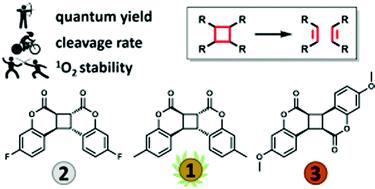Cycloreversion performance of coumarin and hetero-coumarin dimers under aerobic conditions: unexpected behavior triggered by UV-A light†
Abstract
Photochemical [2+2]-cycloadditions of coumarin-like monomers are the textbook paradigms of photo-formation and photo-cleavage reactions. The electronic conjugation length of monomers and dimers is quite different which results in almost fully separated UV/Vis absorption bands in the UV-A and UV-C. This feature enables the selective light-controlled conversion between monomeric and dimeric forms by the choice of the appropriate wavelengths. Several applications are based on this kind of reversible photo linker without absorption in the visible range. But which is the best molecule from the coumarin family for such an application? Within this study, we compared the photochemical cleavage behavior of twelve coumarin-type cyclobutane dimers. In particular, the influence of isomer structure and substitution pattern was studied. Two dimers with an unexpected high quantum yield for cyclobutane cleavage were identified. This behavior is explained through the differing ring strain of the cyclobutane moiety. Electron donating substitutions of the framework, e.g. with a methoxy function (+M-effect), leads to a decreased oxidation potential, making the dimers sensitive towards oxidative dimer splitting. This result disqualifies coumarins, e.g. attached to a polymer backbone via an ether bond, often in the 7-position, because of their instabilities and side reactions in an aerobic environment. The methylated dimers (+I-effect) show excellent stability towards this undesired side reaction as well as a high cleavage efficiency upon irradiation with 265 nm. All twelve investigated dimers are ranked for their quantum efficiency and rate constant for cleavage at 265 nm, as well as their oxygen tolerance. As the most promising derivative within our scope for applications the methylated coumarin dimer was identified.



 Please wait while we load your content...
Please wait while we load your content...